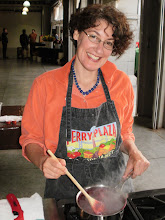A simply sublime little nibble, inspired by an appetizer served by Craig Stoll at Delfina, recreated on the spur of the moment at Diane's cooking class on Monday night.
Fava Bean Crostini
First, the favas. Buy a big bag of favas. Many more than you think you need. Think of each fava pod as a Gulfstream jet--ample, cushy, and much too large for the three or four fat-cat beans reclining inside. Now, put a pot of water on to boil, and crank up something you really like to listen to. Take your bag of favas and strip off all those foamy pods. Don't worry about their pallid little raincoat skins yet. When the water boils, dump favas into water. Let come back to a boil and simmer for a minute or two. Drain and drop into a bowl of ice water. Now, pick up each bean and pinch off the rubbery white outer skin. Drop the pretty bright-green bean halves inside into a little bowl. Yes, a little bowl. That's all you'll need, trust me. When you have your half-cup or so of peeled favas, slide them into a small skillet with a little olive oil, a few tablespoons of water and a pinch of sea salt.
Cook them, stirring, over low heat until tender and nutty tasting--probably around five minutes, maybe less. If you have one of those cute little mini-food-processors, scoop your favas (and whatever liquid might be around them) into the processor, add a squeeze of lemon juice and maybe a little more olive oil and/or water, and pulse to a rough puree. Otherwise, use one of those waffle-grid potato mashers. I think if you tried to chop them they'd just go slithering off in every direction all over the counter, and after all this work, you don't have any to waste. Add some fresh ground pepper, and taste. Does it taste creamy and nutty and green? Good. Only add more salt/lemon if it tastes flat; lemon can really jump right out at you and that's not what you want here. Set aside.
Strip some mint leaves from their stems. Lay the leaves one on top of the other in a little leaf stack. Roll up like a cigar and cut into very fine strips. Ah, mint chiffonade. A word like the tinkle of clear ice in a tall gin and tonic on a summer afternoon--the two words Henry James considered the most lovely in the English language. (No, not mint chiffonade, nor gin and tonic, more's the pity, but summer afternoon. And this from a man wearing a high collar and tie in the middle of July.)
Get out your vegetable peeler and a chunk of pecorino Romano cheese, a firm, salty sheep's milk cheese similar to parmesan. You could use parmesan instead, but in that case I'd look for a young parmesan, one that's still got a little sweetness and elasticity to it, rather than being all stark and aged and granular.
Now, cut some very thin slices of baguette. Toast lightly--best done in the oven at around 350 for about 8 to 10 minutes. Rub very lightly on both sides with a clove of garlic, or (better) a juicy little chunk of spring garlic. Drizzle with olive oil. Return to the oven to continue crisping up and browning. You don't want it much more than golden brown, but you do want it nice and crunchy all the way through. The oven is better for this kind of slow crisping than the toaster, which will give you fast brown edges but a chewy center.
Once your toasts are ready, spread a spoonful of fava mixture onto each toast. Don't be stingy, baby--swirl it on nice and thick, like icing on a Magnolia Bakery cupcake. Strew a few mint strips over the favas. Using your little vegetable peeler, add a sheer curl of pecorino or parmesan cheese. Nicest served while the toasts are still warm, but that's a frill.
All this work and you will probably end up with anywhere from 6 to 12 toasts, depending on how many favas you could bear to peel. Which means, as with fried zucchini blossoms, these should only be served to those people you really, really like.
What you need:
Fava beans
Olive oil
a lemon
Sea salt and freshly ground pepper
About a third of a fresh baguette
Spring garlic or a garlic clove
Some fresh mint
A hunk of pecorino romano cheese
Subscribe to:
Post Comments (Atom)

No comments:
Post a Comment